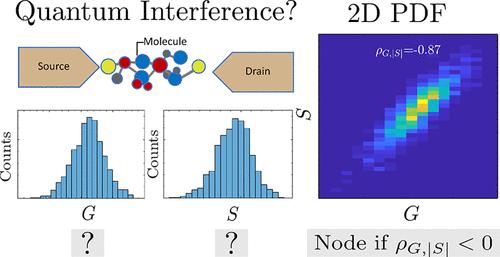当前位置:
X-MOL 学术
›
Nano Lett.
›
论文详情
Our official English website, www.x-mol.net, welcomes your
feedback! (Note: you will need to create a separate account there.)
Identifying Quantum Interference Effects from Joint Conductance–Thermopower Statistics
Nano Letters ( IF 9.6 ) Pub Date : 2024-11-13 , DOI: 10.1021/acs.nanolett.4c04439 Justin P. Bergfield
Nano Letters ( IF 9.6 ) Pub Date : 2024-11-13 , DOI: 10.1021/acs.nanolett.4c04439 Justin P. Bergfield

|
Although quantum effects are thought to dominate the heat and charge transport through molecular junctions, large uncertainties in chemical structure, lead-molecule coupling strengths, and energy levels make it difficult to definitively identify these effects from the measured thermopower S and conductance G distributions alone. Here, we develop a simple statistical method to identify destructive quantum interference features (nodes) through the anticorrelation between simultaneously measured G and S values. We find these correlations can be used to unambiguously identify far-detuned nodes, even when G and S distributions alone cannot. As an example, we consider several para- and meta-configured systems, including benzenediamine and diiodo-terphenyl-based junctions, finding that nodes can be identified in ensembles with broad level-alignment and lead-molecule coupling distributions, and with significant anodal transport contributions, including from vacuum tunneling. The efficacy and limitations of this method are analyzed.
中文翻译:

从联合电导-热功率统计中识别量子干涉效应
尽管量子效应被认为主导着通过分子结的热和电荷传输,但化学结构、铅分子耦合强度和能级的巨大不确定性使得很难仅从测量的热功率 S 和电导 G 分布中明确识别这些效应。在这里,我们开发了一种简单的统计方法,通过同时测量的 G 和 S 值之间的反相关来识别相消量子干涉特征(节点)。我们发现这些相关性可以用来明确识别远失谐节点,即使单独的 G 和 S 分布无法识别。例如,我们考虑了几个对位和元构型系统,包括苯二胺和基于二碘-三联苯的连接,发现可以在具有广泛水平对齐和先导分子偶联分布的集合中识别节点,并且具有显着的阳极传输贡献,包括来自真空隧道。分析了该方法的有效性和局限性。
更新日期:2024-11-14
中文翻译:

从联合电导-热功率统计中识别量子干涉效应
尽管量子效应被认为主导着通过分子结的热和电荷传输,但化学结构、铅分子耦合强度和能级的巨大不确定性使得很难仅从测量的热功率 S 和电导 G 分布中明确识别这些效应。在这里,我们开发了一种简单的统计方法,通过同时测量的 G 和 S 值之间的反相关来识别相消量子干涉特征(节点)。我们发现这些相关性可以用来明确识别远失谐节点,即使单独的 G 和 S 分布无法识别。例如,我们考虑了几个对位和元构型系统,包括苯二胺和基于二碘-三联苯的连接,发现可以在具有广泛水平对齐和先导分子偶联分布的集合中识别节点,并且具有显着的阳极传输贡献,包括来自真空隧道。分析了该方法的有效性和局限性。


















































 京公网安备 11010802027423号
京公网安备 11010802027423号